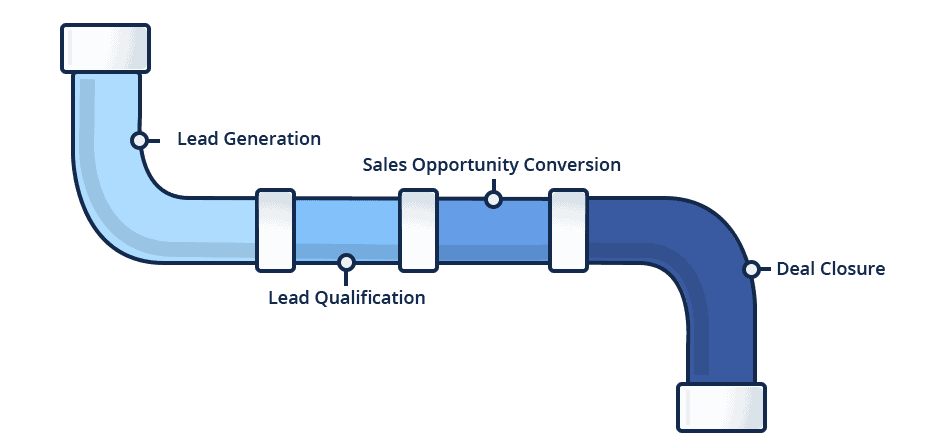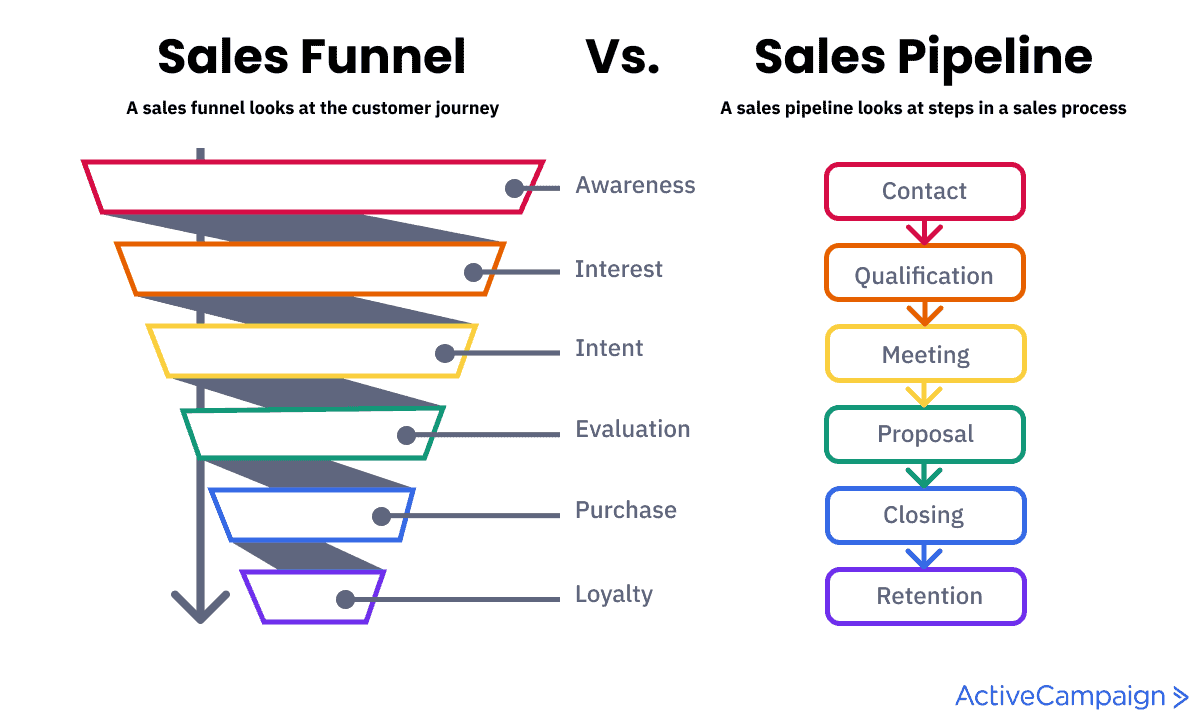The sales pipeline and the sales funnel are not the same.
The sales pipeline is your system of lead generation, qualification, and nurturing. The sales funnel is a visual representation of your potential customers moving through various stages in their decision-making process.
The important thing to know about these two terms is that they don’t refer to one another; they’re both different concepts used for marketing purposes by companies looking for new business opportunities.
If you notice, we’ve highlighted the difference in Italics. The key thing to understand is that the sales pipeline is designed from the perspective of the sales professionals — it is about the steps the sales guys must take, whereas the sales funnel is from the perspective of the potential buyer — what they are doing and might do next.
If that’s a little confusing, don’t worry.
In this blog, we’ll explain sales pipeline vs sales funnel in detail.
Table of Contents
What Is a Sales Pipeline?
A sales pipeline is a systematic approach to prospecting, qualifying leads, selling products or services, and retaining customers.
A sales pipeline functions as the representation of the entire sales process for the sales team to follow and the sales manager to keep track of. Every sales pipeline has opportunities and distinct stages where different actions must be taken by the sales rep.
The sales pipeline typically consists of five distinct stages:
- Lead generation
- Prospect qualification
- Sales meeting
- Sales proposal
- Closing the deal
The length of time it takes for an opportunity to progress from one stage to another depends on how long it takes you to nurture your relationships with prospects before converting them into paying customers. This process is known as lead nurturing.
Sales pipelines are necessary for a business of any size, especially a small business. They help you efficiently organize your revenue-generating activities and measure the efficiency of each stage in the pipeline.
Now, let’s look at how you should approach each of these sales pipeline stages.

Sales Pipeline Stages
When it comes to sales, there aren’t any hard-and-fast rules to guide teams. However, we can define what sales processes look like in general terms, so you can begin drafting your own sales pipeline and make changes to it as per your sales opportunities.
Lead Generation
The first step in sales is to bring leads into the pipeline. That means finding sales leads who need your product or service.
A sales lead enters at the top, usually unaware of your company or what you do. Interest is low and they’re reluctant to buy.
Prospect Qualification
Prospect qualification or lead qualification is where you prune the list. Is the prospect a good fit or not? A buyer persona is the best way to answer this question as it contains the characteristics of your ideal customer.
Use lead scoring to assign a score to each potential buyer based on specific criteria such as engagement, email activity, and pages clicked.
Usually, qualified leads are decision-makers at their company such as the head of marketing, the CEO, or the director.
This is the most important sales pipeline stage as you’ll end up with lower conversion rates if you send an unqualified lead through the pipeline.
Sales Meeting
A sales rep from your team meets with the prospect to discuss the best solution that fits their needs.
The lead moves to the next sales stage if the meeting goes well and they request further information such as a product demo.
Sales Proposal
At this point, you have a clear picture of your prospect and the specific problem they have.
A sales rep puts together a proposal detailing how you intend to solve a problem for them based on your sales meeting.
Closing the Deal
The lead’s journey through your sales pipeline is complete when they sign the deal or you move them to “lost.”
Related blog: Essential Sales Pipeline Stages Every Business Can Use
Why Is a Sales Pipeline Important?
The Harvard Business Review states that companies with effective sales pipeline management have an average growth rate of 15% increase.
Companies that mastered three specific sales pipeline practices had a 28% higher revenue growth.
Related blog: Mid-Funnel Marketing: A Succinct Guide [Definition, Strategies]
What are these practices?
- A clearly defined sales process that shows how the pipeline is designed, measured, and used to drive sales rep performance.
- Spend at least three hours every month on sales pipeline management.
- Train sales managers on pipeline management.
But those aren’t the only reasons why you need a sales pipeline. Here are a few more:
Accurate Sales Forecast
You need a tool to forecast possible revenue on a month-to-month basis, quarterly, and annually.
A sales pipeline shows areas of your sales that are close to the quota and weak points that are far behind.
The data helps you determine leaks in your pipeline so you can adjust your sales strategy and reach your financial goals.
Read also: eCommerce Email Conversion Funnel Analysis Guide For Beginners
Targeted Resources Allocation
It’s easier and more efficient to allocate resources when you know which pipeline stage the prospect is at.
Sales leaders can make decisions about new opportunities, goals, and individual targets that require more resources to close or those that need more oversight.
Improved Tracking
With a sales pipeline, team members can track pipeline deals in real-time throughout the year’s sales cycle.
The data helps managers to understand the volume of new and repeat business the team generates.
It also determines if you need to hire additional sales reps to meet demand and if you’ll meet your sales goals for the year.
What Is a Sales Funnel in Business?
A sales funnel is where you put all of your leads, which includes your website visitors and customers, to determine the number of conversions (or sales).
It’s a way to visualize how many people are moving through your marketing funnel—in other words, it shows the pathway between potential customers first visiting your site or app and converting into a paying customer.
For example, if one thousand people visited your landing page in January this year, but only twenty-five converted into paid customers during that same month, then around six percent of that traffic made an actionable step along the journey.
The rest dropped off somewhere along the path. This path is called the sales funnel.
A sales funnel is widest at the top where awareness is low and narrow at the bottom where awareness is high.
Read also: eCommerce Sales Funnels 101: A Comprehensive Guide for Beginners
Sales Funnel Stages
Awareness — At this stage, the prospect is looking for resources to better understand the problem.
Research — They’ve defined the problem and are looking for possible solutions.
Decision — The prospect has defined the problem, knows about the existing solutions, and is ready to make a decision.
Read also: Cycle Time vs Lead Time: Definitions, Differences, and FAQs
Sales Pipeline vs Sales Funnel
| Sales Pipeline | Sales Funnel | |
| Visualization | Shows the quantity, value, and stages of various open deals. | The funnel offers valuable insight into the volume of open deals at a given time. |
| Tracking | Tracks active leads at different stages of the pipeline. | Tracks conversion of leads on a stage-by-stage basis. |
| Measurement | Measures the quality of leads you drive to the pipeline. | Measures the efficiency of your lead generation efforts. |
| Reporting | Sales pipeline report shows lead activity during the sales process to help sales teams determine where to focus more resources for higher conversion rates. | Sales funnel report shows conversion rates throughout the sales process. Sales teams use the data to improve individual stages of the sales process and prevent leaks in the funnel. |
| Buyer journey representation | From the viewpoint of the sales rep | From the viewpoint of the customer |
| Focus | Activity and value-oriented | Performance and quota oriented |
Here’s an example
When a sales rep says a lead is stuck in the pipeline, that’s means they understand that a prospect needs a little push to move them to the next stage. It could be a proposal or initiating contact.
But a prospect doesn’t “get stuck” in the sales funnel because the funnel stages represent how successful or unsuccessful a prospect converts from the point of initial contact to decision making.
If you want to identify drop-off points year-to-year, the sales funnel shows where deals fail and help your sales team brainstorm solutions.

Read also: A Beginner’s Guide to Lead Funnels: How to Double Your Sales
Do I Need a Sales Pipeline or a Sales Funnel?
It’s important to ask if your sales strategy would benefit from one option or integrating both. The choice you make depends on what your sales process needs.
For brands with high-value products that require a complex buying process, a sales pipeline streamlines the efforts. A pipeline helps new sales reps to quickly understand your sales strategy and track opportunities that may take longer to progress.
But if your company focuses on B2C or you have a shorter B2B sales cycle, a funnel could be a better fit for your team.
Focusing on conversion rate helps team members to identify and eliminate problems while establishing a metric of success for each funnel stage.
For instance, if you notice lower conversion from the lead qualification stage to the proposal stage you’ll want to review your process for lead qualification.
Conversely, if you have trouble booking meetings with a sales qualified lead, you may need to adjust your sales qualifiers.
Diversify your efforts through activities like content marketing to drive more qualified leads into your sales pipeline rather than generic prospecting.
Read also: Marketing Automation Funnel Explained For Beginners
Conclusion: Can I Use a Sales Pipeline and Sales Funnel Together?
Why choose one when you can go for both options? For sustainable sales management, we recommend integrating a sales pipeline and a sales funnel.
Together, they offer valuable insight into how your sales strategies can evolve for higher conversion and close rates.
Using both sales visualizations enables the sales team to identify if your sales process needs more steps or less.
Sales professionals can tweak the sales process to include multiple stages such as product demos, reviewing proposals, identifying decision-makers, and having more sales meetings with leads.
This leads us to the big question. How do you combine both a sales pipeline and a sales funnel?
A sales CRM simplifies the process for you. The built-in lead gen tracker automates the movement of leads through the pipeline. You can also track performance at each stage of the pipeline, monitor growth, and adjust the sales process when needed.
Discover how Engagebay can help you to increase sales. Our award-winning CRM solution enables instant lead follow-up for a higher conversion rate and continued lead tracking for improved efficiency.

